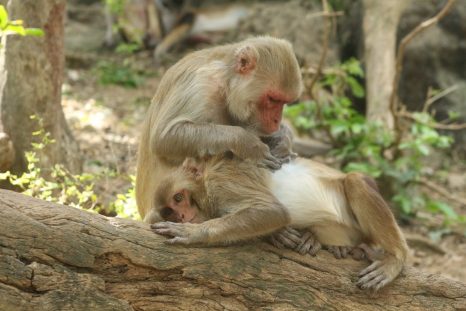Researcher Contact
Jérôme Sallet
Chercheur Inserm
Institut cellule souche et cerveau U1208
E-mail : rf.mresni@tellas.emorej
Téléphone sur demande

A macaque grooming her offspring. An image that illustrates how macaques form relationships. © Noah Snyder-Mackler
The more social relationships we have, the more certain structures in our brain are developed. This has been the hypothesis of various neuroscience research projects for several years. With previous findings having highlighted the role of our social environment as one of the key factors behind the expansion of the cerebral cortex, researchers from Inserm and Université Lyon Claude Bernard Lyon 1, in collaboration with the University of Pennsylvania, went one step further in elucidating this link. They were more specifically interested in a species of macaques whose brain architecture is comparable to that of humans. By observing these non-human primates in their natural state and by analyzing images of their brains, they discovered that the number of companions they have is predictive of the size of certain brain regions associated with social cognition and empathy. The findings of this study have been published in Science Advances.
The links between social network and brain size have already been the subject of neuroscientific studies. For example, scientists have already looked at variations in the size of the human brain amygdala in relation to the number of Facebook friends that a person has1.
In order to build on this research and attempt to find out more about the organization and functions of the neural networks in humans, research teams have worked with an animal species whose brain characteristics are similar to those of humans: the Rhesus macaque.
In a new study, researchers from Inserm and Université Claude Bernard Lyon 1 at the Stem Cell and Brain Research Institute, in collaboration with the University of Pennsylvania, studied a group of these non-human primates in their natural state for several months before taking images of their brains. The fact that the animals were free ranging enabled the scientists to understand the social group in its full complexity. They were therefore able to measure the intensity2 of the interactions with other individuals and identify an animal’s position within the group social hierarchy.
For example, some of the observations focused on grooming partners, which represent direct, important relationships for macaques.
Alongside these behavioral observations, the scientists analyzed brain scans of individuals from the group, which consisted of 103 rhesus macaques, including 68 adults and 21 young macaques under 6 years of age.
In order to better understand how this phenomenon occurs, the scientists also collected brain scans from 21 newborn macaques. The research showed that they are not born with these differences in brain structure size but that they are established during their development.
“Which is interesting because if we had seen the same correlation in young macaques, this could have meant that having a very popular mother (with many interactions with the group) could have predisposed the newborn to also become popular. But in fact our data suggest that the differences we see in adults are strongly determined by our social environments, perhaps more than by our innate predisposition,” explains Jérôme Sallet, Inserm Research Director.
Following this study, the researchers now wish to look at anatomical changes at cell level, in order to reveal the mechanisms behind the increased size of the brain regions that were identified using brain imaging.
1 Kanai R., Bahrami B., Roylance R. and Rees G. 2012. Online social network size is reflected in human brain structure, Proc. R. Soc. B.
2 The researchers measured the number of interactions between the animals, their duration and whether these interactions were cooperative or aggressive.
3 The mid-superior temporal sulcus is involved in social cognition and perception.
Jérôme Sallet
Chercheur Inserm
Institut cellule souche et cerveau U1208
E-mail : rf.mresni@tellas.emorej
Téléphone sur demande
Science Advances, Avril 2022
Camille Testard1*, Lauren J.N. Brent2, Jesper Andersson3, Kenneth L. Chiou4,5, Josue
E. Negron-Del Valle4,5, Alex R. DeCasien6,7,8, Arianna Acevedo-Ithier1, Michala K. Stock9, Susan C. Antón6,7, Olga Gonzalez10, Christopher S. Walker11, Sean Foxley3,12, Nicole R. Compo13,6 Samuel Bauman13, Angelina V. Ruiz-Lambides13, Melween I. Martinez13, J. H. Pate Skene15,16, Julie E. Horvath16,17,18,19, Cayo Biobank Research Unit†, James P. Higham6,7, Karla Miller3, Noah Snyder-Mackler4,5, Michael J. Montague1, Michael L. Platt1,20,21‡, Jérôme Sallet22,23‡*
1 Department of Neuroscience, University of Pennsylvania; Philadelphia, PA, USA
2 Centre for Research in Animal Behaviour, University of Exeter; Exeter, UK
3 Wellcome Integrative Neuroimaging Centre, fMRIB; Oxford, UK
4 Center for Evolution and Medicine, Arizona State University; Tempe, AZ, USA
5 School of Life Sciences, Arizona State University; Tempe AZ, USA
6 Department of Anthropology, New York University; New York, NY, USA
7 New York Consortium in Evolutionary Primatology, NYCEP; New York, NY, USA
8 Section on Developmental Neurogenomics, National Institute of Mental Health, DC, USA
9 Department of Sociology and Anthropology, Metropolitan State University of Denver, CO, USA
10 Texas Biomedical Research Institute, TX, USA
11 Department of Molecular Biomedical Sciences, College of Veterinary Medicine, North Carolina State University, Raleigh, NC, USA
12 Department of Radiology, University of Chicago; Chicago,USA
13 Caribbean Primate Research Center, University of Puerto Rico; Sabana Seca, Puerto Rico
14 Department of Neurobiology, Duke University, Durham, NC, USA
15 Institute of Cognitive Science, University of Colorado, Boulder, CO, USA
16 Department of Biological and Biomedical Sciences, North Carolina Central University, Durham,NC 27707, USA
17 Department of Biological Sciences, North Carolina State University, Raleigh, NC, USA
18 North Carolina Museum of Natural Sciences, Raleigh, NC 27601, USA
19 Department of Evolutionary Anthropology, Duke University, Durham, NC 27708, USA 20Department of Psychology, University of Pennsylvania; Philadelphia, PA, USA
21 Marketing Department, University of Pennsylvania; Philadelphia, PA, USA,
22 Wellcome Integrative Neuroimaging Centre, Department of Experimental Psychology; Oxford, UK
23 Université Lyon 1, Inserm, Institut cellule souche et cerveau U1208; Bron, France